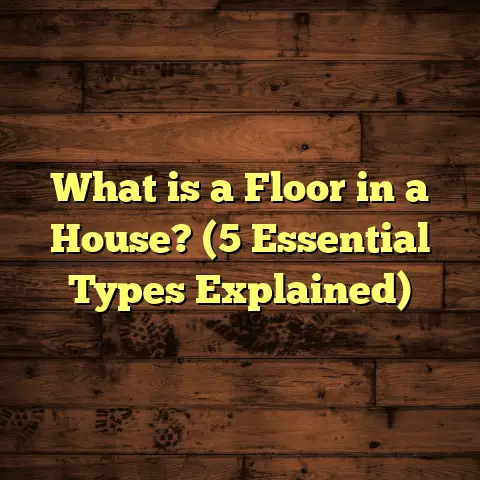What Is Trending Now in Home Floors? (5 Must-Have Styles)
Technology has reshaped almost every part of our homes, and flooring is no exception. Smart tools, innovative materials, and eco-friendly options have changed how people pick floors for their living spaces. I’ve spent years installing and studying floors, and I’m excited to share what’s hot right now in home flooring styles. Whether you’re renovating or just curious, these five must-have styles reflect the blend of beauty, durability, and tech-savvy choices that homeowners crave.
What is Trending Now in Home Floors?
When we talk about trending floors, we’re really looking at styles that combine design, function, and innovation. It’s not just about how a floor looks anymore—though aesthetics still matter a lot—but also how it performs for modern living. Trends often reflect changes in lifestyle, technology, and even sustainability. I’ve noticed a few clear winners after working on countless projects and seeing what clients ask for most.
Why Flooring Trends Matter More Than You Think
Before jumping into the styles themselves, have you ever thought about why flooring trends change? For me, it’s fascinating because floors are one of the biggest design investments in a home. They don’t just affect the look—they influence comfort, maintenance time, indoor air quality, and even resale value.
A few years ago, natural hardwood was king—and still is popular—but it has some downsides like susceptibility to water damage and regular upkeep. Trends now lean heavily toward floors that can handle busy households without losing style. People want floors that fit their lifestyle but also keep pace with innovations in materials science.
I remember working with a family who had three kids and two dogs. They loved the look of hardwood but were tired of scratches and stains. We switched to luxury vinyl planks with a waterproof finish that mimicked wood perfectly. They were thrilled because they got the look without the headaches.
Now let’s get into the five must-have styles that are setting the tone for home flooring today.
1. Luxury Vinyl Planks (LVP) with Enhanced Realism
Luxury vinyl plank flooring has come a long way from its earlier versions. If you’ve ever thought of vinyl as a cheap or unattractive option, it’s time to reconsider. Manufacturers have used advancements in printing and embossing technology to create floors that look virtually indistinguishable from real wood or stone.
What Makes LVP So Popular?
From my perspective as someone who installs floors regularly, LVP hits a sweet spot between affordability, durability, and appearance.
- Waterproof: Unlike hardwood or laminate, LVP stands up to spills and moisture without warping.
- Scratch-Resistant: New wear layers protect against everyday scratches from furniture or pets.
- Comfort: Slightly softer than tile or wood underfoot.
- Easy Installation: Many products offer click-lock systems that make DIY installation much easier.
- Variety: Available in dozens of colors, textures, and finishes that mimic everything from oak to distressed barnwood.
My Personal Experience With LVP
I installed LVP in my kitchen and hallway two years ago because my dog loves water bowls (and sometimes spills). The floor has held up beautifully—no bubbling or peeling. I also appreciate how easy it is to clean with just a mop. The patterns are so realistic that visitors often ask if it’s hardwood.
Data & Industry Insight
According to a 2024 report from the National Wood Flooring Association (NWFA), LVP sales have grown by about 15% annually over the last three years. This growth is driven by rising consumer demand for durable and stylish floors that require less maintenance.
Another interesting statistic: the average lifespan of modern LVP ranges from 15 to 25 years depending on quality and usage, which is comparable to many hardwood floors once refinishing costs are factored in.
Environmental Considerations
Vinyl materials have faced criticism for their environmental impact. However, newer LVP manufacturers are improving eco-credentials by offering products made partially from recycled content and implementing recycling programs for old flooring.
Installation Tips
If you’re thinking about LVP for your home:
- Measure carefully and order about 10% extra material for waste.
- Consider an underlayment pad for added sound absorption and comfort.
- Ensure subfloor is clean, dry, and level.
- Use spacers during installation to allow for expansion.
Case Study: The Smith Family Kitchen Remodel
The Smiths wanted a kitchen floor that looked warm but could handle heavy foot traffic and occasional spills from their two toddlers. After debating between hardwood and tile, we installed LVP in a hickory pattern with a textured finish. The result? Stylish floors that held up beautifully through two years of kids’ messes and family gatherings.
2. Engineered Hardwood with Wide Planks
Engineered hardwood has been around for decades but has recently surged in popularity thanks to wider plank options. Wide planks—often 7 inches or more—offer a modern take on traditional wood flooring.
Why Wide Planks?
Wide planks reduce the number of seams in a room, creating an open look that feels less busy. This appeals to contemporary design tastes favoring simplicity and spaciousness.
Wide planks also show off wood grain patterns more dramatically. If you love natural wood’s character but want something cleaner and more refined than narrow strips, this is the way to go.
My Experience Installing Wide Planks
One recent project involved renovating a 1920s bungalow where original hardwood was too damaged to restore. We chose wide plank engineered oak with a matte finish to keep the vintage charm but add modern durability.
The floor transformed the space—giving it warmth without making it feel cramped or dated.
Performance Benefits
Engineered hardwood consists of a thin veneer of real wood on top of plywood layers arranged crosswise. This construction:
- Resists expansion/contraction better than solid wood
- Is less prone to warping in humid environments
- Can be installed over concrete slabs or radiant heat systems
Maintenance & Longevity
Engineered hardwood can be sanded and refinished several times depending on veneer thickness (usually 2-4 mm). This extends its lifespan compared to laminate or vinyl options.
Market Data
The Hardwood Federation reported that engineered hardwood sales have increased steadily by around 8% per year since 2020, especially in urban markets where moisture control is essential.
Choosing Your Wood Species & Finish
Oak remains the most popular species due to its hardness and grain but other options like walnut, hickory, and maple are gaining traction.
Finishes range from high gloss to matte or hand-scraped textures for a rustic look.
Installation Notes
- Floating installation with click-lock is common.
- Glue-down or nail-down methods provide stability but require professional expertise.
- Subfloor must be flat; minor imperfections can telegraph through thin planks.
Case Study: Urban Loft Renovation
In a downtown loft renovation I handled last year, wide plank walnut engineered hardwood was selected for its rich color and durability. The client wanted authentic wood but worried about humidity damage—engineered wood was ideal here. The final look was stunning and added significant resale value.
3. Sustainable Bamboo Flooring
Bamboo flooring has evolved far beyond its early reputation as an exotic choice. It’s now considered one of the best sustainable flooring options available.
Why Bamboo?
Unlike trees that take decades or centuries to mature, bamboo grows quickly—some species can reach maturity in just five years. This rapid renewability makes it attractive environmentally.
Bamboo also offers great strength and hardness—some types even exceed traditional hardwoods like oak in durability tests.
My Bamboo Flooring Projects
I’ve installed bamboo flooring in several eco-friendly homes where clients wanted low-impact materials without sacrificing style. The variety of finishes—from light blondes to deep caramel tones—makes bamboo versatile enough for many design schemes.
One memorable job was for a family who wanted a “green” floor for their new build. We used strand-woven bamboo with an aluminum oxide finish for maximum durability.
Environmental Impact & Certifications
While bamboo is renewable, harvesting practices vary widely. It’s key to choose bamboo certified by FSC or other reputable bodies to ensure responsible sourcing.
Some bamboo manufacturing techniques use adhesives or finishes with volatile organic compounds (VOCs), so low-VOC products are preferable for indoor air quality.
Durability & Maintenance
Strand-woven bamboo ranks highly on the Janka hardness scale (up to 3000), making it harder than many hardwoods.
Maintenance involves regular sweeping/mopping with appropriate cleaners and avoiding harsh chemicals.
Market Trends & Stats
Global demand for bamboo flooring has risen about 10% annually over the past five years according to industry analyses—driven by growing consumer awareness about sustainability.
Installation Advice
- Bamboo can be installed as floating floors or glue-down.
- Acclimate planks before installation to avoid expansion issues.
- Use recommended finishes to protect against UV fading if exposed to sunlight.
Case Study: Eco-Friendly New Build
For an eco-conscious couple building their dream home last year, we installed carbon-neutral bamboo floors throughout living areas. They loved the warm tones and appreciated the peace of mind knowing their floors came from rapidly renewable resources.
4. Porcelain Tile That Mimics Wood
Porcelain tile might not be your first thought for cozy spaces like living rooms or bedrooms—but wood-look porcelain tiles are changing that perception fast.
What Changed?
Manufacturers now use advanced digital printing combined with textured embossing techniques to recreate wood’s natural grain patterns on tile surfaces. The result is a tile floor that feels like wood visually but offers porcelain’s toughness.
Benefits From My Job Site Perspective
I’ve installed wood-look porcelain tiles in kitchens, mudrooms, even open-plan living rooms where durability was key:
- Waterproof and stain-resistant.
- Virtually scratch-proof.
- Ideal for radiant heating systems.
- Easy cleaning compared to traditional wood floors.
Technical Details
Porcelain is fired at higher temperatures than ceramic tiles, making it denser with less porosity (absorption rate below 0.5%). This makes it highly resistant to water penetration—even ideal for outdoor use in some climates.
Style Options
From distressed barnwood looks to sleek modern planks with gray hues—the color ranges are broad enough to match nearly any interior design style.
Personal Story: Family Mudroom Project
A client with an active family wanted a floor that would survive muddy boots without damage or staining. Wood-look porcelain tile was perfect because it offered warmth visually but handled moisture flawlessly.
They were amazed at how natural it looked yet how easy cleanup was after soccer practice mud tracked inside!
Industry Data
Tile Trends USA reported a 12% increase in sales of wood-look porcelain tile since 2022 as homeowners seek practical yet stylish flooring solutions.
5. Cork Flooring for Comfort and Sound Absorption
Cork isn’t new but it’s definitely having a moment again thanks to growing attention on comfort and noise control at home.
Why Choose Cork?
Cork comes from the bark of cork oak trees harvested sustainably every 9 years without harming the tree itself—making it renewable and eco-friendly.
I’ve used cork flooring in home offices and bedrooms where clients value quiet spaces free from noise distractions.
Comfort Underfoot
Unlike hard tile or wood floors, cork has natural cushioning properties that reduce fatigue when standing or walking long periods—a great feature if you cook or work from home often.
Sound Absorption
Cork’s cellular structure absorbs sound waves effectively—studies show it can reduce impact noise by up to 50%. This makes it perfect for multi-level homes or apartments where noise travels easily.
My Experience With Cork Floors
In one project for remote-working professionals, cork flooring made a huge difference in reducing background noise during virtual meetings. They told me it helped focus better and feel calmer at home.
The natural warmth of cork also adds cozy vibes without needing area rugs everywhere.
Maintenance & Durability
Cork needs sealing to resist moisture but otherwise cleans easily with gentle detergents. Its resilience means dents usually bounce back over time rather than staying permanently.
Market Insights
Cork flooring sales have seen steady growth of around 7% annually over recent years as comfort becomes a priority post-pandemic when more people spend time at home.
Comparing These Styles: Which One Fits Your Home Best?
You might be wondering: with all these options, how do you pick? Here’s how these trends stack up against each other based on key factors:
| Flooring Type | Durability | Water Resistance | Maintenance | Eco-Friendliness | Comfort & Noise Reduction |
|---|---|---|---|---|---|
| Luxury Vinyl Planks (LVP) | High | Excellent | Low | Moderate | Moderate |
| Engineered Hardwood | Moderate-High | Moderate | Moderate | Moderate | Moderate |
| Bamboo | High | Moderate | Moderate | High | Moderate |
| Wood-Look Porcelain Tile | Very High | Excellent | Low | Low | Low |
| Cork | Moderate | Low | Moderate | High | High |
Durability & Water Resistance
Porcelain tile clearly leads if you want something ultra-durable that resists water effortlessly; great for kitchens, bathrooms, or mudrooms.
LVP is also very durable plus waterproof but softer underfoot than tile which can be cold or hard on joints.
Engineered hardwood offers classic warmth but needs protection against moisture; not ideal in damp basements unless carefully installed.
Bamboo performs well but some types are sensitive to humidity changes without proper acclimation or sealing.
Cork offers comfort but isn’t suited for wet areas due to lower water resistance despite sealing treatments.
Eco-Friendliness
If sustainability is your priority:
- Bamboo’s rapid growth cycle makes it highly renewable.
- Cork harvesting preserves trees naturally.
- Engineered hardwood sourced responsibly can also be green.
- LVP and porcelain tile typically have higher environmental footprints but innovations are reducing impacts through recycled content and improved manufacturing processes.
Comfort & Noise Reduction
Cork wins hands down here with its softness underfoot plus excellent sound absorption qualities—great for home offices or apartments needing noise control.
LVP offers reasonable comfort; engineered wood feels warm; porcelain tile tends to feel cold and hard without rugs unless radiant heating is used underneath.
Maintenance
Vinyl plank and porcelain tile are easiest: sweep + mop periodically; stains wipe off easily.
Hardwoods need refinishing every few years depending on wear; bamboo similar but generally durable with correct care.
Cork requires resealing over time but otherwise simple upkeep using gentle cleaners.
Final Thoughts From Years on the Floor (Literally)
Flooring has evolved dramatically thanks to tech innovations affecting materials, manufacturing processes, installation methods, and eco-conscious options. What excites me most is how these trends let homeowners choose floors tailored not only for style but also lifestyle needs—whether that’s wiping up spills fast after kids’ playtime or creating quiet zones for remote work.
Each floor type brings something unique:
- Luxury vinyl planks offer almost unmatched versatility combined with durability.
- Wide plank engineered hardwood balances timeless beauty with modern stability.
- Bamboo stands out as an environmentally friendly yet tough choice.
- Wood-look porcelain tiles marry style with practicality perfectly.
- Cork provides unmatched comfort and noise control while remaining green.
If you want help figuring out what fits your space best or need an accurate cost estimate factoring local labor/material prices plus waste calculations (trust me on avoiding surprises), tools like FloorTally can be invaluable—they simplify budgeting so you can focus on design choices confidently.
Feel free to ask me anything about these options—I’m here to help you make your floors both stunning and smart!





